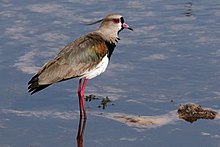Southern lapwing
| Southern lapwing | |
|---|---|
 |
|
| both V. c. lampronotus The Pantanal, Brazil |
|
 |
|
| Scientific classification | |
| Kingdom: | Animalia |
| Phylum: | Chordata |
| Class: | Aves |
| Order: | Charadriiformes |
| Family: | Charadriidae |
| Genus: | Vanellus |
| Species: | V. chilensis |
| Binomial name | |
|
Vanellus chilensis (Molina, 1782) |
|
| Subspecies | |
|
3-4 (see text) |
|
| Synonyms | |
|
Parra chilensis Molina, 1782 |
|
3-4 (see text)
Parra chilensis Molina, 1782
Belonopterus chilensis (Molina, 1782)
Vanellus grisescens Grant, 1912
Dorypaltus prosphatus Brodkorb, 1959
and see text
The southern lapwing (Vanellus chilensis) is a wader in the order Charadriiformes. It is a common and widespread resident throughout South America, except in densely forested regions (e.g. most of the Amazon), the higher parts of the Andes and the arid coast of a large part of western South America. This bird is particularly common in the basin of the Rio de la Plata. It has also been spreading through Central America in recent years. It reached Trinidad in 1961 and Tobago in 1974, and has rapidly increased on both islands.
This lapwing is the only crested wader in South America. It is 32 to 38 cm (13 to 15 in) in length and weighs approximately 250 to 425 g (8.8 to 15.0 oz). The upperparts are mainly brownish grey, with a bronze glossing on the shoulders. The head is particularly striking; mainly grey with a black forehead and throat patch extending onto the black breast. A white border separates the black of the face from the grey of the head and crest. The rest of the underparts are white, and the eye ring, legs and most of the bill are pink. It is equipped with red bony extensions under the wings (spurs), used to intimidate foes and fight birds of prey.
During its slow flapping flight, the southern lapwing shows a broad white wing bar separating the grey-brown of the back and wing coverts from the black flight feathers. The rump is white and the tail black. The call is a very loud and harsh keek-keek-keek.
There are three or four subspecies, differing slightly in head coloration and voice. Vanellus chilensis fretensis from Patagonia is sometimes included in the nominate subspecies V. c. chilensis. The northern subspecies—V. c. cayennensis from north and V. c. lampronotus from south of the Amazon River—are sometimes separated as a distinct species, Vanellus cayennensis. These two subspecies have a browner head—particularly the northernmost birds—and the white face band (broad in the northern and narrow in the southern one) does not reach to the center of the crown. However, birds from the general region of Uruguay apparently intergrade.
...
Wikipedia

